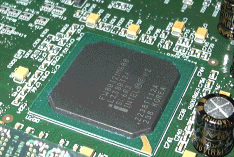 |


Tungsten
80321 development platform

Introduction
Tungsten integrates the unparalleled performance of the Intel XScale microarchitecture based family of processors with an array of peripherals to help designers evaluate and develop on the 80321 without the need to spend time debugging inhouse hardware and low level driver software.
This gives designers a significant time-to-market advantage in being able to demonstrate a working system quickly to their customers, before committing to a cost optimised version of the board.
Architecturally it is suited to running almost any operating system as the hardware is suitably generic to be able to host most popular operating systems such as FreeBSD, WinCE and Linux.
Further information
|
|
Download this page as an Adobe PDF |
|
|
Ask a question about the product |
|
|
Purchasing Tungsten within the USA |
Summary of features
Processor
Tungsten uses the 80321 XScale processor running with a core speed of 600MHz (B1 silicon), along with
|
Interrupt and memory controller
|
| 
PCI controller running at 66MHz (optionally at 133MHz with PCI-X extensions)
|
|
DDR memory support to 200MHz at 64 bit wide (optionally 72 bit including error correction)
|
|
I²C engine, GPIO, SSP
|
|
Separate 32k 32 way set associative I and D caches plus additional 2k mini data cache
|
| |
Memory
- The memory controller supports up to 1Gbyte PC1600 (200MHz) 2.5v DDR RAM
- The operating system of choice is held in single 4 or 8Mbyte (16 bit wide) of 48 pin NOR flash memory, appearing in the memory map at the bottom of the peripheral bus interface ('PBI')
- On board real time clock and 2kbyte NVRAM for persistent settings
Input/output
The board is generously equipped with
- two 64 bit, 3.3v keyed PCI slots
- two 32 bit, 3.3v keyed PCI slots (coexists with the 64 bit bus via a PCI-PCI bridge)
- 10/100/1000baseT gigabit Ethernet interface (RJ45)
- backplane connector for "ISA like" memory mapped peripherals which don't support PCI
- Dual UDMA33/66/100 harddisc interface for up to 4 independent drives
- Floppy disc drive interface (where required)
- USB1.1 compliant universal serial bus root ports
- Serial interface(s) at rates up to 460kbps depending on line driver
- Hardware support for MIDI communications
- Hardware support for IrDA transmission and reception
- Stereo sound input/output capability via supporting AC97 codec
Development support
Development is accelerated by the following aids
- JTAG headers for Multi ICE unit for the 80321
- JTAG header and JTAG chain bypass for the 4 PCI plug in cards
- example source code for common initialisation functions (eg.PCI bus address allocation and DRAM controller setup)
- supplied with 'ready to use' out of the box ROM image containing flash programming tools, serial terminal, disassembler and debugger
- port of Linux in progress based on MVista patches to ARM Linux 2.4
- availability of full circuit diagrams, relevant datasheets, and technical reference manual
Physical dimensions
 | The PCB is a 6 layer microATX formfactor (9.6" x 9.6") to fit slimline rack units and low cost PC cases. |
| The board can be powered by an off the shelf 200W ATX switched mode power supply and mates with a 20 way PSU header, this provides all of the supply rails required including that required by the PCI and backplane, USB, and separate audio circuitry. | |
| Power supplies for 240-260V and 100-120V regions are available. |





